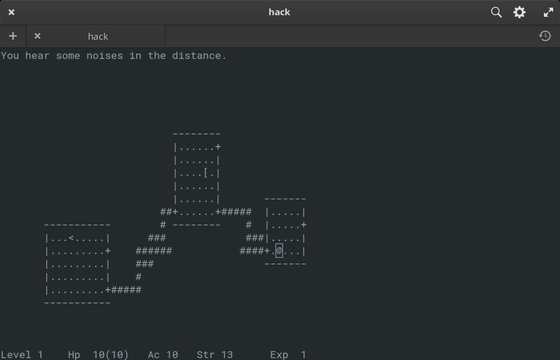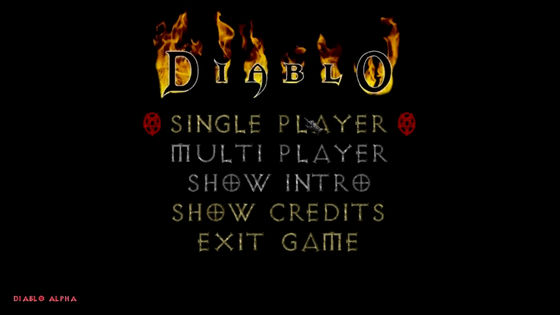The history of one of the biggest game genre 'roguelike games' boasting a 40-year history

Overseas media Ars Technica summarizes the history of '
ASCII art + permadeath: The history of roguelike games | Ars Technica
https://arstechnica.com/gaming/2020/03/ascii-art-permadeath-the-history-of-roguelike-games/
A roguelike game is a game that explores randomly generated dungeons with little or no story. Also, there is a movement to specify the definition of roguelike games in a narrower range, and in the international roguelike game development conference held in 2008, it was defined that it should have a `` permanent death '' element it was done. This means that once a character dies, the game will be over forever. In addition, rogue-like games include 'generating dungeons at random or procedural levels', 'turn-based movement (moving at a relatively fast pace)', 'interaction between complex character / object worlds' and 'finite resources. Elements such as 'necessity of management' and 'player vs. monster' are required.
The original rogue-like game was the ' Rogue ' released in 1980, but it is said that this rogue was influenced greatly by the ' Dungeons & Dragons ' of the table talk RPG that appeared in 1974. ' Pedit5 ', the earliest computer RPG that appeared in 1975.
The oldest surviving computer RPG called 'pedit5' is a game based on Dungeons & Dragons that appeared in 1974, where players operate characters from a bird's-eye view and defeat monsters in 40-50 rooms. Explore the one level dungeon. In the case of Dungeons & Dragons, the dungeon is composed of multiple levels, and there are elements such as traps hidden on the floor and bosses waiting at the end of the dungeon, but these elements are omitted in pedit 5 . pedit5 is a game that includes a 'permanent death' element because if you defeat a monster, the game will be over.
PEDIT5 (1975) on PLATO System-Gameplay-YouTube
In addition, ' Colossal Cave Adventure ', which appeared in 1977, is a game that includes a 'permanent death' element. Colossal Cave Adventure seems to have no elements of the roguelike game other than the `` permanent death '' element, but `` adventures in underground caves full of danger to every corner '' and `` It included many unique elements, such as the humorous process and the point of seeking creative solutions to problems. However, dungeons are completely fixed and are not randomly generated for each adventure, so they have the drawback that once you understand the composition, you can easily clear them.
Colossal Cave Adventure play-through-YouTube
Released in 1978, Beneath Apple Manor includes up to 10 randomly generated dungeons, game screens rendered with text and graphics, customizable difficulty, and battles with monsters. It contains many of the elements required for roguelike games. However, since Beneath Apple Manor was only playable on Apple II until it was ported to IBM PC and Atari game consoles in 1983, it did not become a big trend.
Beneath Apple Manor for the Apple II-YouTube
In 1980, Glenn Wifman , a student at the University of California at Santa Cruz, and Michael Toy collaborated to add elements such as `` randomly generated dungeons '' and `` monster items '' to the Colossal Cave Adventure. is created.
The two created a dungeon consisting of multiple hierarchies consisting of up to nine rooms using a programming library for UNIX systems called curses . The dungeon changes the arrangement of rooms, weapons and objects randomly each time you play. In the rogue, one uppercase alphabetic character represents monsters (26 types), and the character operated by the player is represented by '@'. Players couldn't move faster or slower than monsters, and the turn progressed each time they read text, looked for traps, and used items. Actions such as swinging weapons, putting on armor, throwing weapons, and moving are assigned to the keyboard, and it seems that experienced people and gamers easily died from the difficulty.
Wifeman and Toy distribute the rogues to all UC campuses. After moving to the University of California at Berkeley in 1982, he added a new developer, Ken Arnold, and succeeded in gaining further popularity by improving the rogue. In 1984, the rogue was officially added to BSD 's Unix version 4.2, so it became possible to play rogue on computers of universities and research institutions around the world, and it became more popular.
Rogue the Adventure Game: The First Rogue (like) from 1980-YouTube
As the name 'roguelike game', the genre starts with 'game like rogue'. From 1980 to 1982, an attempt to remake the rogue started with the RPG ' Hack ' developed by Jay Fenlason. Fenlason has created a simple clone game with his high school classmates so that he can no longer play the rogue he was playing, so he can play the rogue again.
By adding elements such as 'exact dungeon generation algorithm', 'about twice the number of monsters', and 'more complex character / item / monster interaction' to this clone game, the clone game is completely different game 'Hack'. Reborn. Hack, created as part of a high school student's play, was sent to USENIX in 1982 by creator Fenlason. At the top of the source file, it was stated that 'permission to use, modify, and redistribute the program' was specified.
In December 1984, two years after Fenlason sent Hack data to USENIX, Dutch mathematician and computer programmer Andries Brouwer reported on Hack's archives at the National Institute of Mathematics and Information Science. Discover data Brouwer, who actually played Hack, started programming immediately and created four new versions of Hack. We will improve the original version of Hack by receiving feedback from colleagues at the National Institute of Mathematics and Information Science.
Additional elements added by Brouwer include `` a two-part worm that attacks between the head and tail, '' `` a pet fighting with the player, '' `` more monsters, '' `` fortune cookies, '' `` dungeons visited in the past, There are various ways to return to the hierarchy, such as “shop” and “job”.

Like Fenlason's Hack, Moria is the beginning of a rogue-inspired roguelike game. The game is based on a rogue inspired by JR R Tolkien's novel 'The Ring Story, ' developed by Robert Alan Koeneke, who worked in a computer science lab at the University of Oklahoma.
Moria expands the dungeon hierarchy from 26 levels in the rogue to about 50 levels, which is about twice as large, and restricts each level of the dungeon from 9 × 9 rooms to create more free dungeons Upgrade by losing. By adding monsters that move around at different speeds for each level of the dungeon, improvements have been made so that tactical elements are required for battles with monsters rather than rogues.
Moria gameplay (PC Game, 1992)-YouTube
Roguelike games such as Hack and Moria are born after the release of the rogue, but the development of the two roguelike games is ceased relatively soon. However, the termination of development does not mean that roguelike games such as Hack and Moria have lost their popularity.
In July 1987, a roguelike game called ' NetHack ' was born. Although new weapons and jobs, castles and special hierarchies have been added, Ars Technica basically has to be out of the scope of 'games that extend Hack'. However, the word ' YASD ' (another stupid death) has come from the NetHack community.
Let's Play NetHack! Part 1: A Tourist Enters the Dungeon-YouTube
In 1986, ' Larn ' and ...
Larn gameplay (PC Game, 1986)-YouTube
In 1987, the Finnish roguelike game ' SpurguX ' appeared. These take over elements of two roguelike games, Hack and Moria.
SpurguX (pc dos)-YouTube
After that, ' Umoria ' based on Moria, which was born after 1987, and ...
Umoria (Acorn Archimedes game 198?)-YouTube
Various roguelike games will be born, such as ' Angband ', which started operation in 1991.
Let's Play Angband (P1)-YouTube
Other roguelike games, such as The Dungeon Revealed in 1987, Omega in 1988, UnReal World in 1992, and Ragnarok in 1993, are slightly off the road. There is.
Rogue and its direct roguelike games were all stuck on expressing the game world with ASCII art. However, some developers have embraced new inspiration from other genres, such as `` Scarab of Ra '' released in 1988, combining Rogue with a first-person maze game, `` Maze War '' It is a work like a sword.
Let's Play Scarab of Ra-YouTube
The origin of the roguelike game to play from the first person viewpoint for those who have played games on MS-DOS was 'Moraff's Revenge' released in 1988. It seems to be a very simple roguelike game except that monsters and dungeons are drawn from the first person perspective.
Moraff's Revenge (DOS)-Dungeon Crawling in MS-DOS-Saturday Afternoon Gaming-YouTube
' Dungeon Hack ', born in 1993, is a roguelike game developed for commerce and developed from a first-person perspective. You can customize trap frequency, food availability, monster difficulty, and more, and optionally add a 'permanent death' element.
Dungeon Hack (PC / DOS) 'Demo' 1993, SSi, DreamForge-YouTube
Rogue came to Japan around 1986, and became popular through the PC-8800 series of PCs sold by NEC.
Ars Technica mentions ' The Labyrinth of Death ' released for megadrives in 1990 as 'the first Japanese roguelike game I could find.' Ars Technica points out that the ' Dragon Crystal Tulani's Labyrinth ', released in the same 1990, is inappropriate as a rogue-like game because it lacks a 'permanent death' element.
Labyrinth of Death (Mega CD 1994) OP & ED-YouTube
Ars Technica described the Labyrinth of Death as 'a game that is very similar to a rogue, despite being a typical
In 1993, Chunsoft released the roguelike game ' Torneko's Great Adventure Mystery Dungeon ' as an epic work of the Dragon Quest series. The idea was to bring the elements of Dragon Quest to the roguelike game. This initiative has achieved enormous success in Japan, and has led to a mysterious dungeon series that has created various roguelike games, such as ' Chocobo's Mysterious Dungeon ', ' Pokemon Mysterious Dungeon ', and ' Kiraku Shiren '. To go.

After that, elements of roguelike games are gradually being added to other game genres. In particular, since the 1990s, roguelike designs have increased in commercial games. Ars Technica wrote, ' Tojam & Earl ', released for Mega Drive in 1991, was 'the first game to cleverly disguise its roots as a roguelike game behind a colorful look and many clever designs' I am.
Diablo , born in 1996, has been described as a great help in bringing roguelike games to the mainstream. However, he pointed out that there is 'no depth or complexity' as in traditional roguelike games.
A plan for the action MORPG monument `` Diablo '' shining in the history of the game is on sale-gigazine

Furthermore, ' DRL ', which appeared in 2002, is a combination of popular FPS DOOM and roguelike games. DRL draws FPS, which is originally at the exact opposite position of roguelike games, into the same genre by enabling long range attacks like DOOM.
DoomRL-(Doom the Roguelike)-YouTube
Desktop Dungeons , launched in 2013, and Road Not Taken , 2014, are titles that further demonstrate the versatility of roguelike games, combining roguelike elements with puzzle games. Elsewhere , 2015's Hand of Fate combines roguelike and card game action RPG elements. There are other games, such as Spelunky , that, while clearly not a roguelike game, inherit the elements of a roguelike game.
A roguelike game that has had a great influence on other genres while achieving various evolutions, but if you think that the beginning was `` gamers independently localized the game called rogue '', a roguelike game Ars Technica wrote that the way the elements spread through various genres and evolve is 'appropriate evolution'.
Related Posts:







